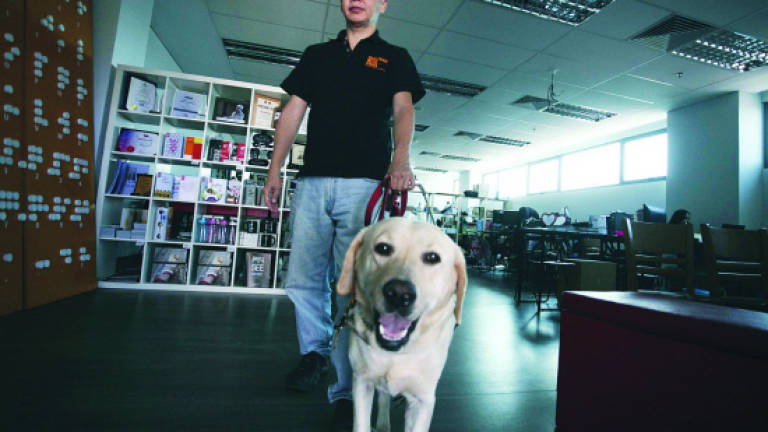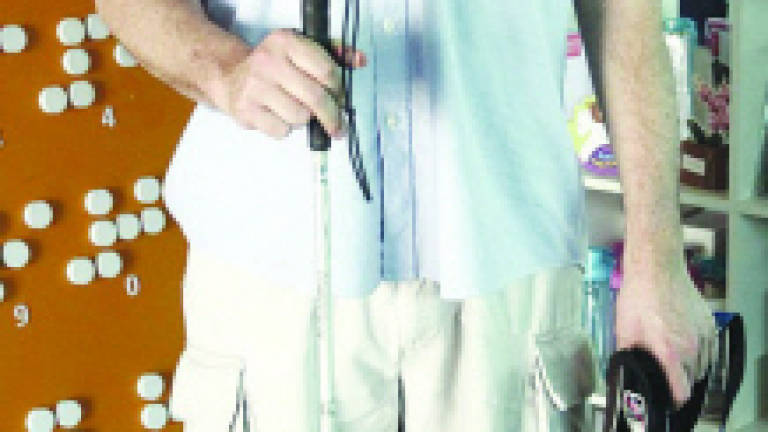Welcome to the dark side


ARE you afraid of the dark? If your answer is yes, people with visual loss or impairment may convince you that life can be just as colourful in their world. In fact, living in pitch-darkness doesn't limit them from carrying out day to-day tasks shared by most people, as I learnt recently at the Malaysian franchise of Dialogue in the Dark (DID), a social enterprise that's present in over 30 countries.
I had the privilege of walking 45 minutes in the shoes of the blind through DID's exhibition in Sunway University, made up of a series of rooms in complete darkness. After a short briefing and introduction to the use of a long cane by my host Nawal Khairil Anwar, my colleague and I nervously stepped into the darkened gallery, and boy was I glad to hear our guide Erik Weinstock calling out for us from inside.
With the cane, I prodded the ground before me and navigated towards his voice. Weinstock quizzed us on the pit stops (jungle, market, cafe, etc.) of our tour, and had us interacting with our surroundings via our auditory and tactile senses. From deciphering the number plate of a motorcycle, shopping for groceries, to paying with the correct banknotes, and pouring creamer into your tea (without burning yourself!); suddenly all these no-brainers became challenging to perform.
In a controlled setting, where there was a guide and constant interaction to take your mind off the fear and anxiety, living in the dark didn't seem as daunting. But Weinstock, 54, assured me that the world doesn't end when you lose your sight – little or all of it – for real.
The engineer – who also worked with DID back in the US – was born with a rare form of macular degeneration called choroideremia, which takes a lifetime for his eyesight to deteriorate.
"Because of my condition, I was in denial for about 16 years. When I had more vision, I'd look at things longer, or get someone else to look at it for me. Finally it got so bad, that I couldn't fake it anymore. I stopped driving in my late 30s.
"I had to accept it, adapt and learn how to be blind. For a full year at Atlanta's Centre for the Visually Impaired, I took Braille and keyboard training; mobility and orientation training; and learnt activities of daily living," shared Weinstock, who is temporarily serving DID Malaysia under the local Volunteering for International Professionals (VIP) Fellowship Programme.
EQUIPPED TO SERVE
Like Weinstock and most DID workers around the globe, Nawal is trained to host visitors and guide them through the exhibition. Here in Malaysia, DID workers also run a telemarketing centre in collaboration with telecommunications service provider Digi. The initiative falls under the Academy of Light, DID's mechanism to equip and empower visually-impaired children and adults with more knowledge. This includes internet marketing, language and arts, and soon, aromatherapy massage and computer skills too.
"They come for classes, part-time or full-time, and we pay them. They learn and work at the same time. Most of the guides are already doing formal work while some are studying. When they have time, they come here to work with us," explained Stevens Chan, founder and CEO of DID Malaysia.
Not only do DID's tour and telemarketing services allow people with visual impairment or disabilities to be seen as contributors – rather than burdens – to society, Chan said the work is exciting for the staff because they don't often get to interact with the public, and that helps their self-esteem.
Indeed, Nawal – who's taking TESL (Teaching English as a Second Language) courses while having optic glioma – shared that she enjoys meeting new people. "Working in DID, I got to know that many foreigners are living in Malaysia!"
When asked the most valuable lesson she picked up from joining DID, the 25 year-old unveiled that she could now identify banknotes without looking at them. She tipped, "RM1 and RM5 have a plastic-like texture, and I tell them apart by their lengths. As for the bigger notes, I distinguish them by their widths."
COUNT THEM IN
Established in Germany, Dialogue in the Dark was founded by journalist Andreas Heinecke in 1988 to push back the widespread prejudice about blindness by "inviting blind and sighted people to meet under reverse conditions". The social enterprise aims to continue promoting awareness about social inclusion of blind and disabled people on a global level.
"It's really through DID that the non-disabled community understands that the world of the blind is not that bad after all – they can actually work. But there's always been a stigma that limits the blind from becoming more than a masseur or telephone operator. Even in education, they don't usually get to study anything else but anthropology or social science.
"Once we've equipped them, it's up to the government or corporate bodies to look beyond their disability and offer them the opportunities. Who knows the surprises they can bring?" Chan suggested.
Weinstock echoed this sentiment, adding that he appreciates understanding, inclusion and empathy – not sympathy. He also advised against saying, "Do you need help?" to people with visual loss or impairment because the message – although well-meaning – rubs off as presumptuous and demeaning.
He elaborated, "It implies that I need help. Instead, the coolest thing a person can do is walk up to me and say, 'Can I offer you any assistance?' It's a ? at-out offer – you're not judging me. You can even say that to a sighted person. In fact, it's a nice thing for everybody to say to anybody."